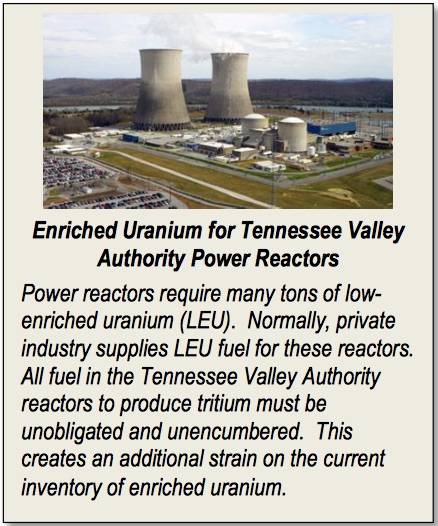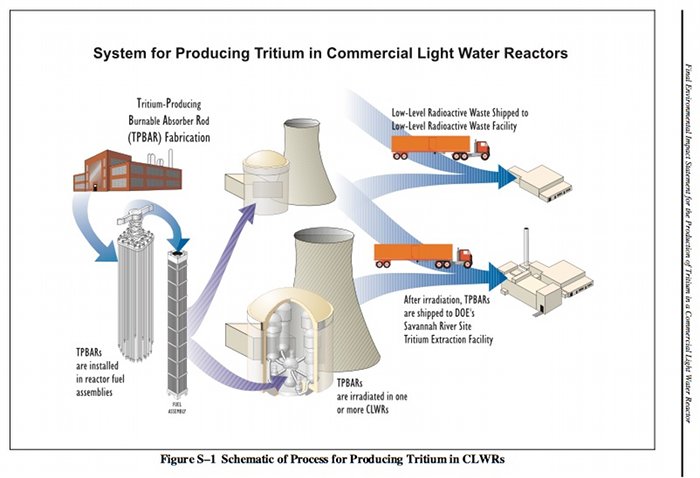About 20 metric tons of highly enriched uranium could be “down-blended” to low-enriched uranium and transferred to the Tennessee Valley Authority for use as a fuel to produce tritium for nuclear weapons, according to a public notice published in the Federal Register this week.
The project involves the Y-12 National Security Complex in Oak Ridge and Watts Bar Nuclear Plant near Spring City in Rhea County, among other sites.
The National Nuclear Security Administration and TVA announced in August that they intend to enter into an agreement to “down-blend” highly enriched uranium to low-enriched uranium in order to help produce tritium, a key “boosting” component in nuclear weapons.
The highly enriched uranium used for the “down-blending” will be processed, packaged, and shipped from Y-12, according to the NNSA. Y-12 is an NNSA site, and it is the main storage facility for certain categories of highly enriched uranium.
Low-enriched uranium, or LEU fuel, is used in a TVA commercial power reactor, Watts Bar Nuclear Plant Unit 1. Tritium is produced there by irradiating lithium-aluminate pellets with neutrons in rods known as tritium-producing burnable absorber rods, or TPBARs.
The irradiated rods are then shipped to the Savannah River Site, an NNSA production facility near Aiken, South Carolina. The Savannah River Site extracts the tritium from the irradiated rods, purifies it, and adds it to the existing inventory, according to the NNSA’s Fiscal Year 2018 Stockpile Stewardship and Management Plan.
U.S. Energy Secretary Rick Perry determined in August that the transfer of the low-enriched uranium from U.S. Department of Energy inventories to help produce tritium would serve a national security purpose.
“Down-blending HEU (highly enriched uranium) to low-enriched uranium supports the Department’s defense missions and promotes national security by enabling tritium production necessary to support the nuclear weapons stockpile,” Perry said in the secretarial determination.
The uranium transfers will be conducted under the USEC Privatization Act of 1996, which provides for the transfer of enriched uranium for national security purposes, as determined by the secretary.
The United States does not currently have a fully domestic uranium enrichment capability, according to this week’s public notice, which was published by the NNSA in the Federal Register on Tuesday.
“The U.S. uranium enrichment market consists of foreign enrichment technologies that cannot be used to meet national security requirements for enriched uranium,” said the public notice, which was signed by Philip T. Calbos, NNSA acting deputy administrator for defense programs.
There are efforts to restore the nation’s domestic uranium enrichment capability, but the NNSA, a DOE agency, said it will take time to develop enrichment technologies and allow for a thorough analysis.
So, NNSA’s domestic uranium enrichment strategy includes NNSA Defense Programs down-blending about 20 metric tons of highly enriched uranium to low-enriched uranium for use as fuel in tritium production reactors, the public notice said.
“The uranium will be transferred to the NNSA federal partner, the Tennessee Valley Authority, only for use as fuel in a reactor producing tritium and not for resale or retransfer,” the public notice said. “TVA will pay for the value of uranium to be received. Use of this material is compliant with long-standing U.S. policy and international commitments that require LEU used for defense purposes to be free of peaceful use restrictions (unobligated). TVA is responsible for preserving the unobligated LEU to be used as fuel in tritium production reactors.”
In an August press release, the NNSA said the down-blending campaign is part of a strategy to provide a reliable and economical source of unobligated enriched uranium that will run from 2019 through 2025. TVA will provide material management and storage logistics through 2040, the NNSA said.
“NNSA must down-blend its unobligated HEU inventory to provide LEU for defense missions because there is no source of unobligated enriched uranium available through the open market today,” the press release said.
The NNSA said the down-blending agreement with TVA that was announced in August is separate from an existing irradiation agreement that started in 2000 and is in effect until November 30, 2035
TVA has been producing tritium for the NNSA by irradiating tritium producing burnable absorber rods, or TPBARs, in Watts Bar Unit 1 since 2003.
There is a possibility that tritium could be produced for the NNSA in additional nuclear power plant units, including Watts Bar Nuclear Plant Unit 2. An operating license amendment being considered by the U.S. Nuclear Regulatory Commission would allow TPBARs to be loaded into Watts Bar Nuclear Plant Unit 2, according to a public notice published in the Federal Register in June.
Tritium from irradiated rods from TVA are not the only source of tritium today, according to the Fiscal Year 2018 Stockpile Stewardship and Management Plan, which was published by the NNSA in November. The primary source is “end-of-life” gas transfer system reservoirs that have been returned to the Savannah River Site, the NNSA said.
Tritium production
Two years ago, the NNSA announced that it wanted to be able to irradiate up to 5,000 TBPARs every 18 months using TVA reactors at both Watts Bar and the two-unit Sequoyah site, near Soddy-Daisy in southeast Tennessee.
“Although near-term tritium requirements could likely be met with the irradiation of 2,500 TPBARs every 18 months, this decision provides the greatest flexibility to meet potential future needs that could arise from various plausible but unexpected events,” the NNSA said in a record of decision published in the Federal Register on June 22, 2016. “The exact number of TPBARs to be irradiated during each/any 18-month reactor core cycle will be determined by both national security requirements and TVA reactor availability.”
In a notice published in the Federal Register last year, TVA said it had agreed in June 2016 to evaluate the potential for producing tritium in the second unit at Watts Bar, Unit 2. As a result of that assessment, TVA planned to submit a license amendment to the Nuclear Regulatory Commission in late 2017 to authorize the irradiation of up to 1,792 TPBARs in Watts Bar 2, possibly by December 2025. If the license amendment is approved, tritium production in Watts Bar 2 could start in the fall of 2020, TVA said.
TPBARs could also be irradiated at the Sequoyah site in the future, TVA said, but there are no current plans to irradiate them there.
Tritium is a radioactive isotope of hydrogen that has two neutrons and one proton. It has been described as an essential component in every nuclear weapon in the U.S. stockpile. It occurs naturally in small quantities but must be manufactured to obtain useful quantities. It enables weapons to produce a larger yield while reducing the overall size and weight of the warhead in a process known as “boosting,” the U.S. Department of Energy said in an environmental impact statement about 20 years ago.
But unlike other nuclear materials used in nuclear weapons, tritium decays at a rate of 5.5 percent per year—its half-life is about 12 years—and it must be replenished periodically.
For more information, see this story published in August. It includes more information on producing tritium and enriched uranium sources.
More information will be added as it becomes available.
Most news stories on Oak Ridge Today are free, brought to you by Oak Ridge Today with help from our advertisers, contributors, and subscribers. This is a free story. Thank you to our advertisers, contributors, and subscribers. You can see what we cover here.
Do you appreciate this story or our work in general? If so, please consider a monthly subscription to Oak Ridge Today. See our Subscribe page here. Thank you for reading Oak Ridge Today.
Copyright 2018 Oak Ridge Today. All rights reserved. This material may not be published, broadcast, rewritten, or redistributed.



Leave a Reply